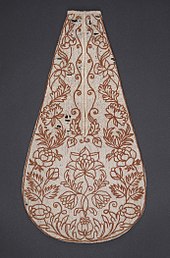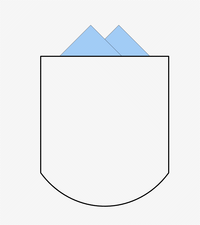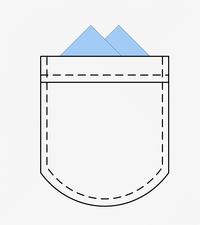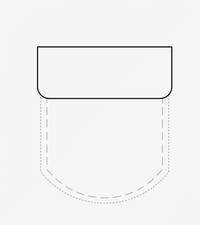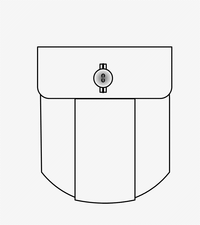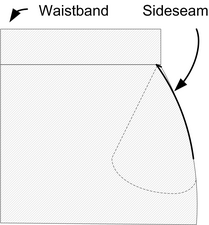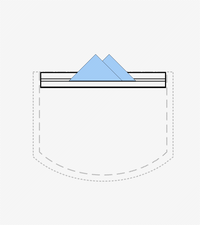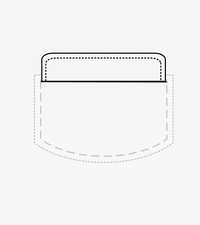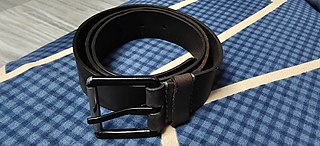
A belt is a flexible band or strap, typically made of leather, plastic, or heavy cloth, worn around the natural waist or near it. The ends of a belt are free; and a buckle forms the belt into a loop by securing one end to another part of the belt, at or near the other end. Often, the resulting loop is smaller than the hips. Belts come in many lengths because of the variety in waist sizes, and most belts can be adjusted at the buckle to suit the wearer's waist.

A shirt is a cloth garment for the upper body.
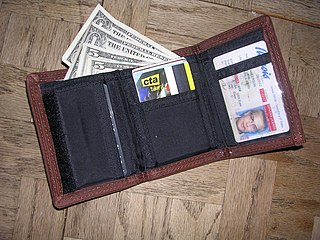
A wallet is a flat case or pouch, often used to carry small personal items such as paper currency, debit cards, and credit cards; identification documents such as driver's license, identification card, club card; photographs, transit pass, business cards and other paper or laminated cards. Wallets are generally made of leather or fabrics, and they are usually pocket-sized and foldable.

A petticoat or underskirt is an article of clothing, a type of undergarment worn under a skirt or a dress. Its precise meaning varies over centuries and between countries.

In fashion, an accessory is an item used to contribute, in a secondary manner, to an individual's outfit. Accessories are often chosen to complete an outfit and complement the wearer's look. They have the capacity to further express an individual's identity and personality. Accessories come in different shapes, sizes, hues, etc. The term came into use in the 20th century.

A handbag, commonly known as a purse in North American English, is a handled medium-to-large bag used to carry personal items. It has also been called a pocketbook in parts of the U.S.
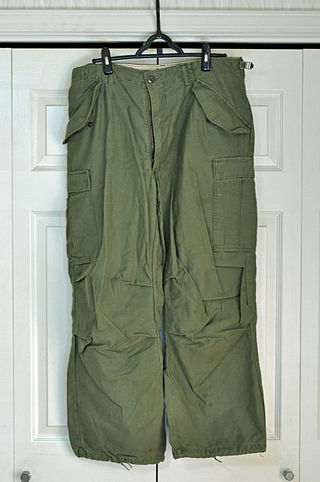
Cargo pants or cargo trousers, also sometimes called combat pants or combat trousers after their original purpose as military workwear, are loosely cut pants originally designed for rough work environments and outdoor activities, distinguished by numerous large utility pockets for carrying tools.

A pleat is a type of fold formed by doubling fabric back upon itself and securing it in place. It is commonly used in clothing and upholstery to gather a wide piece of fabric to a narrower circumference.
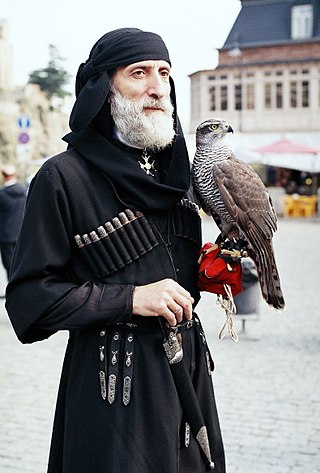
A chokha, also known as a cherkeska, is a woolen coat with a high neck that is part of the traditional male dress of peoples of the Caucasus. It was in wide use among Avars, Abazins, Abkhazians, Eastern Armenians, Azerbaijanis, Balkars, Chechens, Circassians, Georgians, Ingush, Karachays, Nogais, Ossetians, Tats, the peoples of Dagestan, as well as Terek and Kuban Cossacks who adopted it from the aforementioned peoples.

Fashion in fourteenth-century Europe was marked by the beginning of a period of experimentation with different forms of clothing. Costume historian James Laver suggests that the mid-14th century marks the emergence of recognizable "fashion" in clothing, in which Fernand Braudel concurs. The draped garments and straight seams of previous centuries were replaced by curved seams and the beginnings of tailoring, which allowed clothing to more closely fit the human form. Also, the use of lacing and buttons allowed a more snug fit to clothing.

Outside Western cultures, men's clothing commonly includes skirts and skirt-like garments; however, in the Americas and much of Europe, skirts are usually seen as feminine clothing and socially stigmatized for men and boys to wear, despite having done so for centuries. While there are exceptions, most notably the cassock and the kilt, these are not really considered 'skirts' in the typical sense of fashion wear; rather they are worn as cultural and vocational garments. People have variously attempted to promote the fashionable wearing of skirts by men in Western culture and to do away with this gender distinction.

Costume during the thirteenth century in Europe was relatively simple in its shapes and rich in colour for both men and women, and quite uniform across the Roman catholic world, as the Gothic style started its spread all over Europe in dress, architecture and other arts.
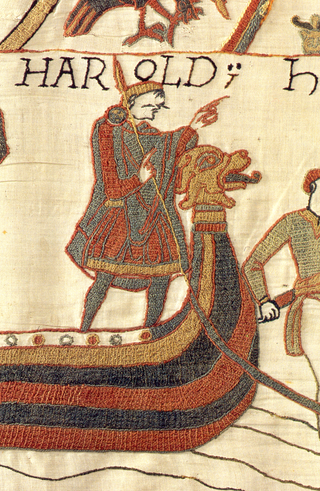
Anglo-Saxon dress refers to the clothing and accessories worn by the Anglo-Saxons from the middle of the fifth century to the eleventh century. Archaeological finds in Anglo-Saxon cemeteries have provided the best source of information on Anglo-Saxon costume. It is possible to reconstruct Anglo-Saxon dress using archaeological evidence combined with Anglo-Saxon and European art, writing and literature of the period. Archaeological finds have both supported and contradicted the characteristic Anglo-Saxon costume as illustrated and described by these contemporary sources.

Trousers, slacks, or pants are an item of clothing worn from the waist to anywhere between the knees and the ankles, covering both legs separately. In the United Kingdom, the word pants generally means underwear and not trousers. Shorts are similar to trousers, but with legs that come down only to around the area of the knee, higher or lower depending on the style of the garment. To distinguish them from shorts, trousers may be called "long trousers" in certain contexts such as school uniform, where tailored shorts may be called "short trousers" in the UK.

The modern Greek Army has a history of almost 200 years, during which it has undergone dramatic changes and been involved in some of the major conflicts on the European continent. The modern Greek military throughout its history was closely following international developments in equipment and uniforms. With the notable exception of the elite Evzones units, which based their uniforms on the indigenous traditional garments of the 18th century, the rest of the Army, as most militaries worldwide, was always quick to adopt the military fashion current among the armies of the influential Great Powers. This influence can be roughly divided in three periods: French-style uniforms, which dominated throughout the 19th century, the British styles introduced around World War I and used during World War II and until the late 1960s, and the "NATO" or US-style predominating from ca. 1968 onward. Various individual items or details can of course be traced to other influences, and there were also transitional uniforms combining previous designs.
The Medieval period in England is usually classified as the time between the fall of the Roman Empire to the beginning of the Renaissance, roughly the years AD 410–1485. For various peoples living in England, the Anglo-Saxons, Anglo-Danes, Normans and Britons, clothing in the medieval era differed widely for men and women as well as for different classes in the social hierarchy. The general styles of Early medieval European dress were shared in England. In the later part of the period, men's clothing changed much more rapidly than women's styles. Clothes were very expensive and both the men and women of lower social classes continued also divided social classes by regulating the colors and styles these various ranks were permitted to wear. In the early Middle Ages, clothing was typically simple and, particularly in the case of lower-class peoples, served only basic utilitarian functions such as modesty and protection from the elements. As time went on the advent of more advanced textile techniques and increased international relations, clothing gradually got more and more intricate and elegant, even with those under the wealthy classes, up into the renaissance.

Shalwar kameez is a traditional combination dress worn by women, and in some regions by men, in South Asia, and Central Asia.

An overskirt is a type of women's short skirt which is draped over another garment, such as a skirt, breeches, or trousers. Although peplum is often used as another term for overskirt, it should not be confused with the peplos or "peplum dress", which was worn in ancient Greece.

A bag is a common tool in the form of a non-rigid container, typically made of cloth, leather, or other materials. The use of bags predates recorded history, with the earliest bags being lengths of animal skin, cotton, or woven plant fibers, folded up at the edges and secured in that shape with strings of the same material. Bags are used for carrying items like personal belongings, groceries, or other objects. They comes in various shapes and sizes, often equipped with handles or straps for easy carrying.

History of clothing in the Indian subcontinent can be traced to the Indus Valley civilization or earlier. Indians have mainly worn clothing made up of locally grown cotton. India was one of the first places where cotton was cultivated and used even as early as 2500 BCE during the Harappan era. The remnants of the ancient Indian clothing can be found in the figurines discovered from the sites near the Indus Valley civilisation, the rock-cut sculptures, the cave paintings, and human art forms found in temples and monuments. These scriptures view the figures of human wearing clothes which can be wrapped around the body. Taking the instances of the sari to that of turban and the dhoti, the traditional Indian wears were mostly tied around the body in various ways.


